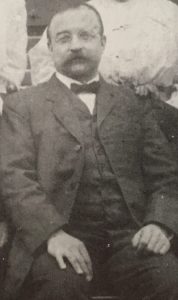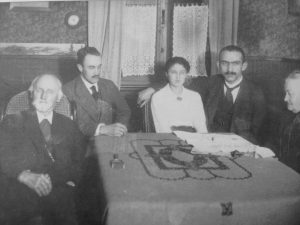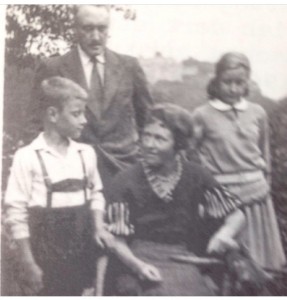Author’s Note: If you are interested in more tricks for deciphering the old German script in your genealogy documents, check out my new book on the topic, Tips and Tricks of Deciphering German Handwriting!
You have your German genealogy document. You are feeling relatively confident with the handwriting. But those letters just don’t seem to be forming any word you can find in the dictionary. What could be going on?
As German spelling was not standardized until the end of the 19th century, the spelling of words in handwritten documents can often be rather “creative”, to say the least. In these types of situations, the trick to deciphering the handwriting is: Think like a German! (*For a simple chart of spelling variations, see the end of the article*).
What does it mean to think like a German, you ask? Well, in the German language, even today, many certain letters sound the same to German speakers. Case in point: I was once in a book shop in Austria, and had placed an order for a book. The bookseller asked for my last name, upon which I replied with my maiden name, Portnoy. He looked at me and said, “Now, would that be with a hard P or a soft B?” Confused, I replied, “It’s just a P. You know, Puh, Puh!”
Upon further inquiry, I found out that the Germans have a hard time telling the difference between their spoken P and B. They have therefore applied adjectives (hard and soft) to the letters to clarify which consonant they mean. For Americans, P and B are very distinct (although they are made at the same place in our mouth), but for Germans, they need that extra description to be sure which letter is meant. And this leads to the fact that many German writers of the past misspelled P words with B’s and vice versa.

K and G: For any linguists out there, you may now be recognizing a pattern. Just as B and P are spoken at the same place in our mouths, K and G are also formed in the same part of the mouth as one another (what differentiates these letters from each other is that the B and G are voiced, meaning our vocal cords vibrate when we make these sounds, while the P and the K are voiceless, with no vocal cord vibration). Again, English speakers make a bigger distinction between these sounds than German does, which means that our German ancestors often mixed up the K and the G in writing (in very creative cases, a K or a G may also have been used for a CH).
T and D: Just as the above letter pairs, the only distinction between these letters is whether the vocal cords vibrate or not, meaning that there is not a big difference in these sounds for German speakers. So if a word is not making any sense and you can’t find it in a dictionary, try replacing the T with a D or vice-versa.
F and V: In German, the letter V sounds like the F sound, meaning many German speakers often mixed up the two letters. Case in point: I once translated a letter from a German person living in America, written in German. The author was describing his occupation, and wrote the word “Varmer.” After puzzling what this random German word could be, I then realized that the author meant “farmer” in English, but had misspelled it with a V.
C and K: C is not a very common letter in German today, but in some words of the past, they did use a C where a K would be written today.
Extra H’s: You will often see many words in old German documents that have an H included where no H would be written today. Some examples include:
- verheirathet (verheiratet) – married
- thun (tun) – to do
- Thräne (Träne) – tears
- Monath (Monat) – month
For further examples, see here: https://de.wikipedia.org/wiki/Deutsche_Rechtschreibung_im_sp%C3%A4ten_19._Jahrhundert
Umlauts: Most German writers did use the umlaut (two dots above A, O, and U) but some preferred to write this sound as AE, OE, and UE. You can see this in the spelling of certain last names today. For instance, my German ancestors’ last name was “Müller”, but our family spells the name “Mueller” today. So if your ancestor wrote a word with “ae”, but you can’t find it in the dictionary, try typing “ä”.
EI and EY: Some words spelled with EI today were spelled with EY in the past (with two dots over the Y). Examples:
- bey (bei) – preposition meaning many different things, depending on the context (http://dict.leo.org/englisch-deutsch/bei)
- seyn (sein) – to be
- Freytag (Freitag) – Friday
EU and EI: Depending on the region of Germany, Austria or Switzerland, some authors may have pronounced EU words (normally pronounced as the OY in boy) as EI (like the I in bike). Some examples:
- eich (euch) – you all
- Freind (Freund) – friend
ß and S: ß (Eszett, or sharp S, pronounced as S) is still used in German today, although the rules on when to use it have changed. This means that you may often see ß in words where an S or two S’s would be used in German today.
I and IE: In the past, German writers often substituted an IE for what would only be an I today. Example:
- giebt (gibt) – to give (or Es giebt/Es gibt – There is…)
I and J: If you go centuries back into the past, you may see some words written with a J today that were written with an I back then. One example is:
- Iahr (Jahr) – year
While there are many more spelling variations, these are some of the most common ones. So if your word is not appearing in any online dictionary, try substituting its German equivalent, and see what you can find! And if you don’t want to puzzle through the mysteries of German spelling, you can always contact me here for translation help.
German Spelling Variations
| Letter One (These Were Interchanged With One Another) | Letter Two (These Were Interchanged With One Another) |
| b | p |
| k | g |
| t | d |
| f | v |
| The Below Letters Are the Standard Spelling Today: | The Below Letters Were Used More Often in the Past (as substitutes for left column): |
| k | c |
| no h | additional h |
| ä, ö, ü | ae, oe, ue |
| ei | ey |
| eu | ei |
| s/ss | ß (also used in standard spelling, although not as often) |
| i | ie |
| j | i |







10 Responses
Hello! I am just beginning to build our family tree and I have two different spellings for my great great grandfather who was born in Bayern, in 1822….. Franz Rofsrucker is written on the back of his picture, but, my aunt who started the geneology search has spelled it Rossrucker. Could his name have been changed on entry to U.S.?
I think it would likely be a mistranscription. An “ss” can sometimes look like an “fs”, because the first “s” was often written with what looks like an “f” otherwise. So Rossrucker would be more likely.
The confusion with the sound of P and B had a big impact on my genealogy research for a couple of decades!. The only information that I have for one of my 2*great grandmothers was that she was born in Pretzeirheim, Prussia. For years and years I searched for her in records from Pretzeirheim and other towns that I thought sounded the same. It was one of my major brick walls.
When someone told me about P and B, I decided to try towns starting with B instead. Almost immediately my brick wall crumpled. The correct name of her birth place was Bretzenheim Nahe. Now I have found records for 3 generations of her family there.
That’s a great example, George! Thanks so much for sharing. I’m glad you found her birthplace!
My biological grandfather’s name was Julius Willy – with an umlaut over the “y”. Strikes me as an affectation. Oder?
They actually put umlauts over the y in the past sometimes – doesn’t change the name at all! I usually translate into English without it.
Very interesting and helpful!!
Two things come to mind related to surnames I’m researching: (1) “Schlagetter” spelling is only traceable to my specific family line; while “Schlageter” is another family line. Ancestry pro advised us that the two families probably split off before recordkeeping 1,700 or pre 1,700. (2) We had a tough time tracking down our Maier family line, spellings included Meier, Mayer and Meyer! DNA finally solved the mystery!
That’s great – DNA can be a huge help!
My surname is spelled in myriad ways in both German and U.S. records, sometimes differently at two places in the same record. Occasionally, it is spelled starting with a P or V rather than a B. My ancestors hail from Andelfingen, a village adjacent to and presently administered by Langenenslingen in the Biberach district of Wurttemberg. When LDS transcriptions of Andelfinged births and marriages came on line, I was able to trace back the family to the mid 1600s. I noticed that prior to 1800, the surname was usually spelled “Braeumayer” and after 1800, the “Braeu” became “Brei” or “Brey.” I thought that perhaps the LDS divided the records at the year 1800 between two transcribers who provided the two different spellings or the priests that made the original entries changed about 1800. I wonder if this change somehow relates to the standardization of German mentioned in this blog or if anyone else has noticed shifts in spelling about the year 1800.
That’s an interesting theory – I’d have to do some research about the exact timing of earlier spelling changes!